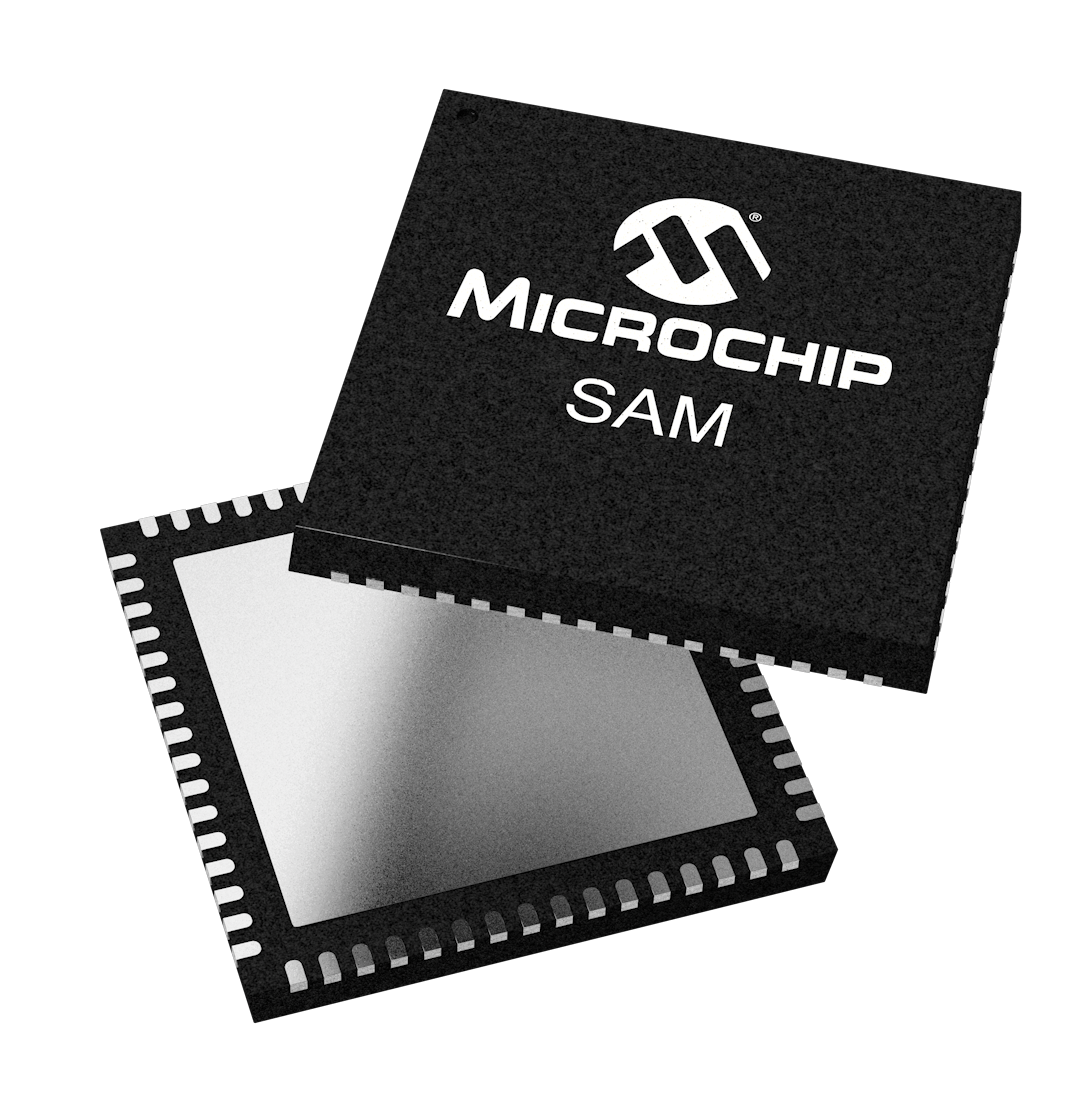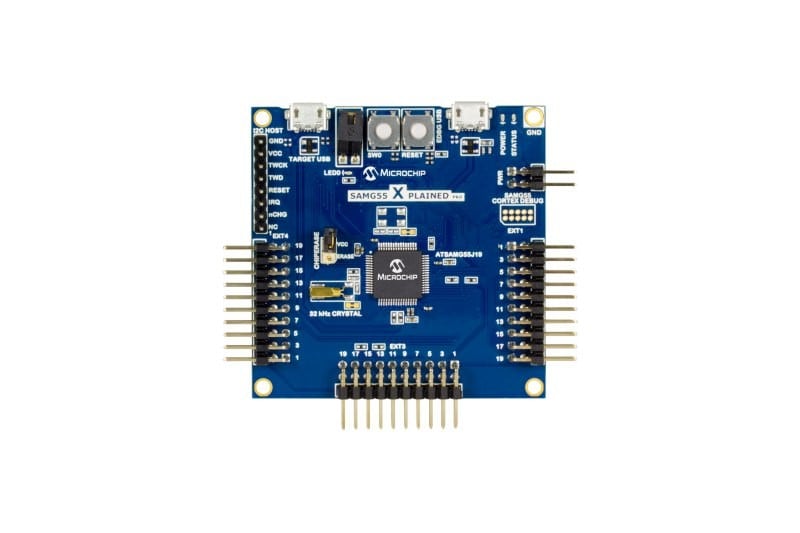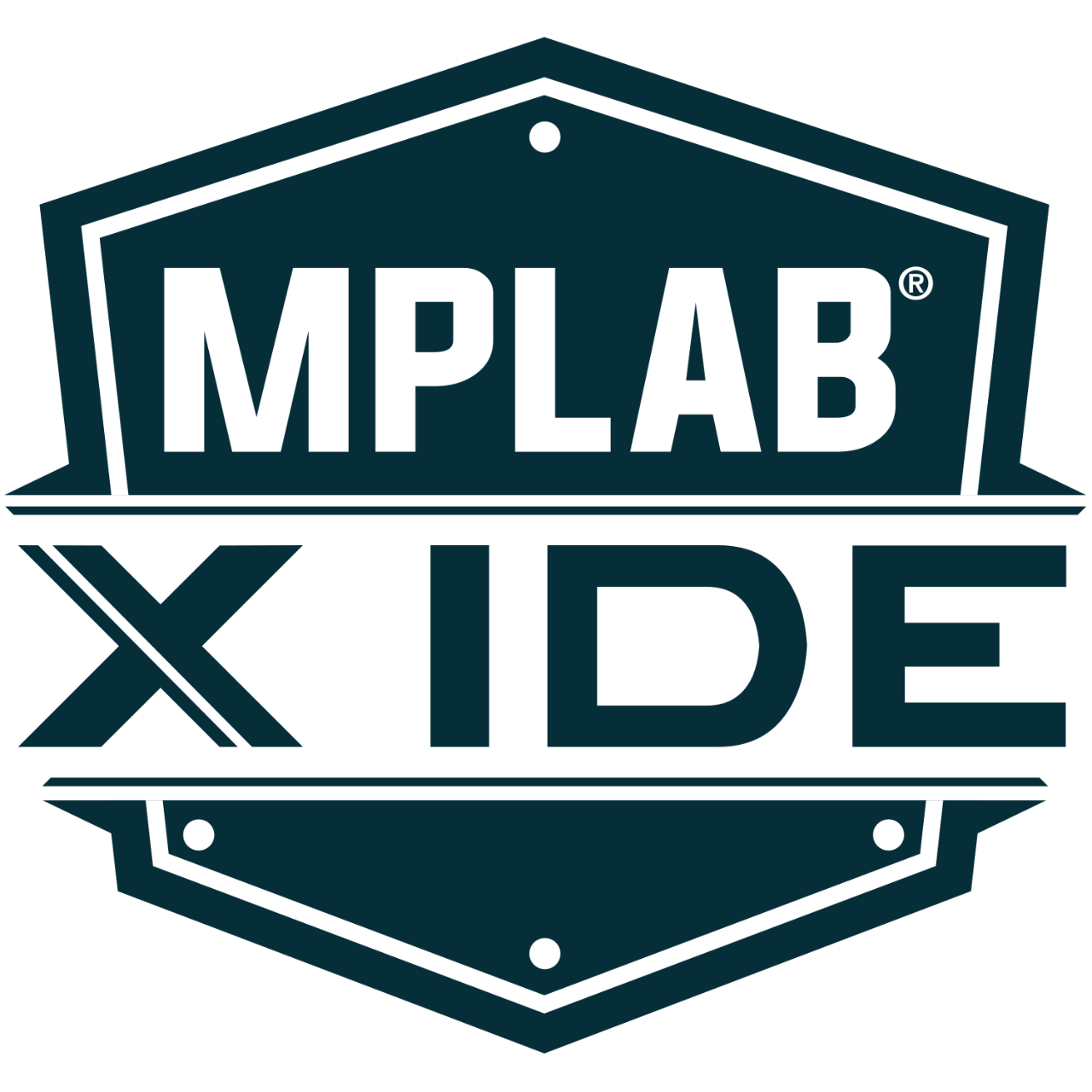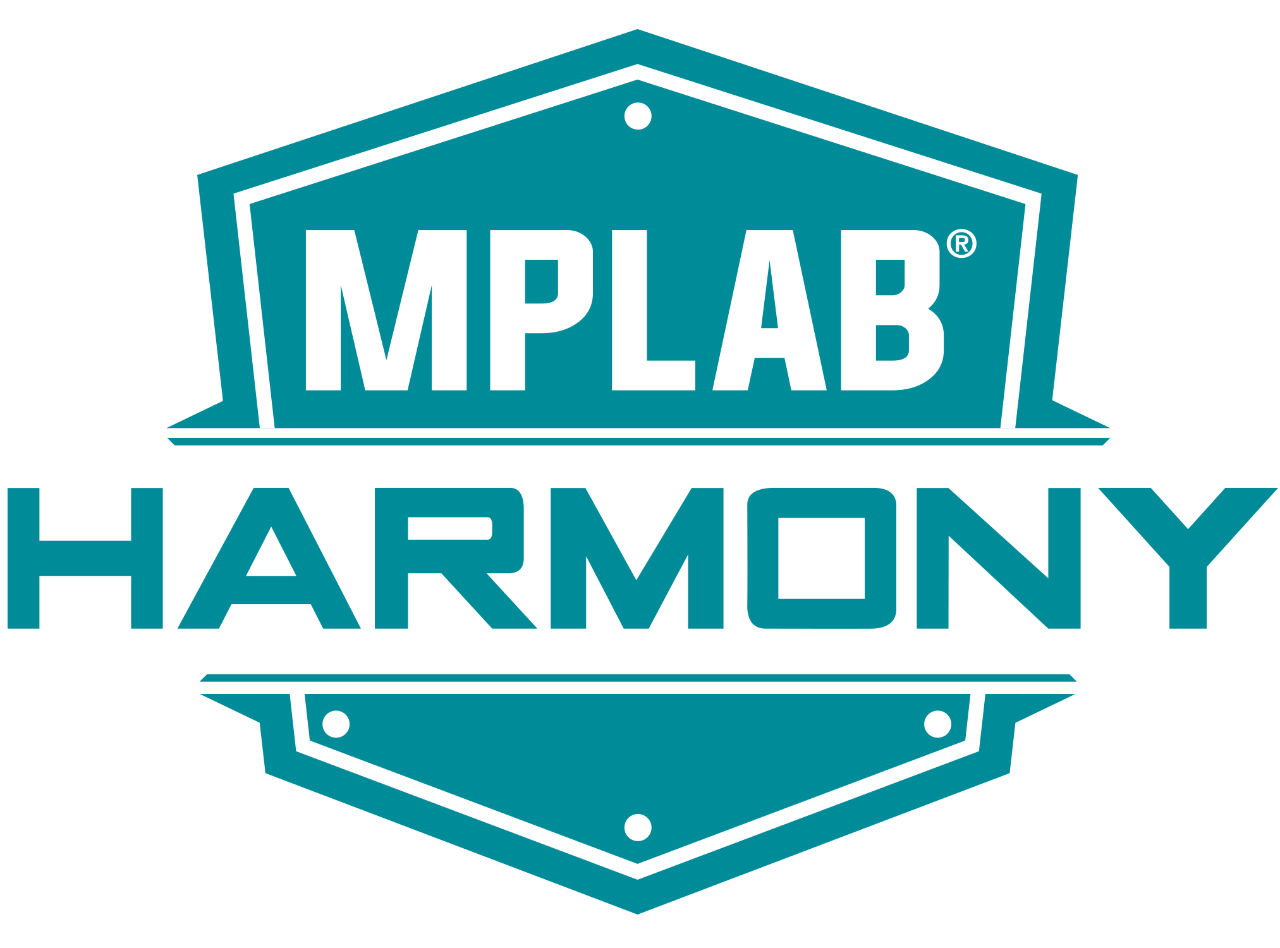SAM G MCUs Based on Arm® Cortex®-M4F Core
The SAM G family is optimized for ultra-low-power and high-performance applications. Its small form factor is based on an Arm Cortex-M4F core and, bundled with a Floating-Point Unit (FPU), these devices offer unrivaled efficiency in a tiny 3 × 3 mm, 49-ball WLCSP package. The SAM G family is optimized with a highly efficient set of serial peripherals including a 12-bit Analog-to-Digital Converter (ADC), Direct Memory Access (DMA) and a good SRAM-to-Flash ratio. SAM G devices are ideal for sensor hub and battery-operated consumer applications.
The SAM G family comes in four series, the SAM G51, SAM G53, SAM G54 and SAM G55. These devices are fully compatible, even down to the WLCSP package.

SAM G51 MCUs
The SAM G51 series of Flash MCUs is based on the high-performance 32-bit Arm Cortex-M4 RISC processor with FPU. It operates at a maximum speed of 48 MHz and features up to 256 KB of Flash and up to 64 KB of SRAM. The peripheral set includes one USART, two UARTs, two I2C-bus interfaces (TWI), one high-speed TWI, up to two SPIs, one three-channel general-purpose 16-bit timer (TC), one Real-Time Timer (RTT) and one 8-channel 12-bit ADC.
Key Features
- Arm Cortex-M4 based MCU running up to 48 MHz
- 256 KB embedded Flash and 64 KB SRAM
- Power consumption in active mode ~103 µA/MHz
- Low-power modes
- Wait mode 6.8 µA
- Wake-up time from wait mode to active mode 3.2 µs
- FPU
- DSP instructions
- 12-bit 8-channel Analog-to-Digital Converter (ADC)
- 49-ball WLCSP and 100-lead LQFP package options
SAM G53 MCUs
The SAM G53 series of Flash MCUs is based on the high-performance 32-bit Arm Cortex-M4 RISC processor with FPU. It operates at a maximum speed of 48 MHz and features up to 512 KB of Flash and 96 KB of SRAM. The peripheral set includes one USART, two UARTs, three I2C-bus interfaces (TWI), up to two SPIs, two three-channel general-purpose 16-bit timers, two I2S™ controllers with two-way, one-channel pulse density modulation, one RTT and one 8-channel 12-bit ADC.
Key Features
- Arm Cortex-M4 based MCU running up to 48 MHz
- 512 KB embedded Flash and 96 KB SRAM
- Power consumption in active mode ~102 µA/MHz
- Low-power modes
- Wait mode 8 µA
- Wake-up time from wait mode to active mode < 5 µs
- FPU
- DSP instructions
- 12-bit 8-channel ADC
- 49-ball WLCSP and 100-lead LQFP package options
SAM G54 MCUs
The SAM G54 of Flash MCUs is based on the high-performance 32-bit Arm Cortex-M4 RISC processor with FPU. They operate at a maximum speed of 96 MHz and feature up to 512 KB of Flash and 96 KB of SRAM. The peripheral set includes one USART, two UARTs, three I2C-bus interfaces (TWI), up to two SPIs, two three-channel general-purpose 16-bit timers, two I2S controllers with two-way, one-channel pulse density modulation, one RTT, one Real-Time Clock (RTC) and one 8-channel 12-bit ADC.
Key Features
- Arm Cortex-M4 based MCU running up to 96 MHz
- 512 KB embedded Flash and 96 KB SRAM
- Power consumption in active mode ~102 µA/MHz
- Low-power modes
- Wait mode 8 µA
- Wake-up time from wait mode to active mode < 5 µs
- FPU
- DSP instructions
- 12-bit 8-channel ADC
- 49-ball WLCSP and 100-lead LQFP package options
SAM G55 MCUs
The SAM G55 series of Flash MCUs is based on the high-performance 32-bit Arm Cortex-M4 RISC processor with FPU. It operates at a maximum speed of 120 MHz and features 512 KB of Flash and up to 176 KB of SRAM. The peripheral set includes eight flexible communication units comprising USARTs, SPIs and I2C-bus interfaces (TWIs), two three-channel general-purpose 16-bit timers, two I2S controllers, one-channel Pulse Density Modulation (PDM) interface, one 8-channel 12-bit ADC, one RTT and one RTC, both located in the ultra-low-power backup area.
Key Features
- Arm Cortex-M4 based MCU with up to 16 KB SRAM on I/D bus providing 0 wait state execution at up to 120 MHz
- Up to 512 KB embedded Flash and up to 176 KB SRAM
- 8 KB ROM with embedded bootloader, single cycle access at full speed
- Power consumption in active mode ~102 µA/MHz
- Low-power modes
- Wait mode 8 µA
- Wake-up time from wait mode to active mode < 5 µs
- FPU
- DSP instructions
- 12-bit 8-channel ADC
- 49-ball WLCSP, 64-lead LQFP and 64-lead QFN package options
Similar Devices

SAM G55 Xplained Pro Evaluation Kit
Part Number: ATSAMG55-XPRO
The SAM G55 Xplained Pro Evaluation Kit enables evaluation and prototyping with SAM G55 Cortex®-M4 based microcontrollers. Extension boards to the SAM G55 Xplained Pro can be purchased individually.

MPLAB® X Integrated Development Environment (IDE)
MPLAB X Integrated Development Environment (IDE) is an expandable, highly configurable software program that incorporates powerful tools to help you discover, configure, develop, debug and qualify embedded designs for most of Microchip’s microcontrollers and digital signal controllers. MPLAB X IDE works seamlessly with the MPLAB development ecosystem of software and tools, many of which are completely free.

MPLAB Harmony v3 Software Framework
MPLAB Harmony v3 is a flexible, fully integrated embedded software development framework for 32-bit microcontrollers (MCUs). It enables robust framework development of interoperable RTOS-friendly libraries with quick and extensive Microchip support for third-party software integration. MPLAB Harmony includes a set of peripheral libraries, drivers and system services that are readily accessible for application development. The code development format allows for maximum re-use and reduces time to market.
- Application Notes
- Brochures
- Data Sheets
- Errata
- Product Documents
- Technical Briefs
|
Title
|
|
|---|---|
| AT09002: SAM I2C - SPI Bootloader | Download |
| AT07216: SAM G55 Schematic Checklist | Download |
| AT08220: Universal Synchronous Asynchronous Receiver Transceiver (USART) | Download |
| AT07896: Universal Asynchronous Receiver Transceiver (UART) | Download |
| Production Programming of Microchip AVR and SAM Microcontrollers | Download |
| AT09331: ASF USB Stack Manual | Download |
| AN_42382 - AT04056: Getting Started with FreeRTOS on SAM Flash MCUs | Download |
| AT08642: SAM3A/3N/3S/3U/3X/4E/4N/4S/G Peripheral DMA Controller (PDC) Driver | Download |
| AT07898: SAM3/4S/4L/4E/4N/4CM/4C/G Timer Counter (TC) Driver | Download |
| AT06864: SAM3/4C/4CM/4CP/4E/4N/4S/G Reset Controller (RSTC) Driver | Download |
| AT07890: SAM4 Serial Peripheral Interface (SPI) | Download |
| AT07337: SAM4 Real-Time Clock (RTC) | Download |
| AT03155: Real-Time-Clock Calibration and Compensation | Download |
| EMI, EMC, EFT, and ESD Circuit Design Consideration for 32-bit Microcontrollers Application Note | Download |
| AN_42282 - AT07336: Common Non-Volatile Memory (NVM) Driver | Download |
| AN_42341 - AT09336: USB Device Interface (UDI) for Human Interface Device Mouse (HID Mouse) | Download |
| AN_42342 - AT09337: USB Host Interface (UHI) for Human Interface Device Mouse (HID Mouse) | Download |
| AN_42340 - AT09335: USB Device Interface (UDI) for Human Interface Device Keyboard (HID Keyboard) | Download |
| AN_42343 - AT09338: USB Device Interface (UDI) for Mass Storage Class (MSC) | Download |
| AN_42344 - AT09339: USB Host Interface (UHI) for Mass Storage Class (MSC) | Download |
| AN_42345 - AT09340: USB Device Interface (UDI) for Vendor Class Device | Download |
| AN_42346 - AT09341: USB Host Interface (UHI) for Vendor Class Device | Download |
| AN_42337 - AT09332: USB Device Interface (UDI) for Communication Class Device (CDC) | Download |
| AN_42339 - AT09334: USB Device Interface (UDI) for Human Interface Device Generic (HID Generic) | Download |
| AN_42338 - AT09333: USB Host Interface (UHI) for Communication Class Device (CDC) | Download |
| AN_42319 - AT06861: SAM Supply Controller (SUPC) | Download |
|
Title
|
|
|---|---|
| SAM G55 Series Family Silicon Errata and Data Sheet Clarifications | Download |
|
Title
|
|
|---|---|
| Basic 32-Bit MCU Design and Troubleshooting Checklist | Download |
Microchip Bootloaders
Bootloaders are used to upgrade firmware on a target device without using an external programmer or debugger. Commonly used with microcontrollers (MCUs), a bootloader contains code that loads and executes an application program. Bootloaders can also perform additional tasks such as validating the code integrity and authenticity.

How to Set-up the Tools Required to Get Started with MPLAB® Harmony v3
This video helps to set-up the tools required to get started with MPLAB® Harmony v3. It is a step-by-step guide explaining:
• How to Download & Install MPLAB® X Integrated Development Environment (IDE)
• How to Download & Install MPLAB® XC32 Compiler
• How to install the MPLAB Harmony Configurator (MHC)
• How to Download MPLAB Harmony Framework from Harmony 3 GitHub Repo
Some key benefits of MPLAB® Harmony v3 include:
• Core agnostic implementation which supports both MIPS® and Arm® Cortex® core architectures
• Code portability with consistent APIs that can be used across different device families
• Easily configurable using MPLAB Harmony Configurator’s (MHC’s) Graphical User Interface (GUI)
• Optimized peripheral libraries to simplify device setup and peripheral usage
• Modular software downloads and updates available through GitHub for better installation and configuration management
• Offers same great middleware
• Default integration with FreeRTOS and capable of supporting other Real-Time Operating Systems (RTOSes)
• Supports multiple development models with application examples and demos
• Offers 1000+ demo/application examples

Create Your First Project with SAMD21 using MPLAB Harmony v3
Create Your First Project with SAMD21 Using MPLAB® Harmony v3
MPLAB® Harmony 3 is a software development framework consisting of compatible and interoperable modules that include peripheral libraries (PLIBs), drivers, system services, middleware and third-party libraries. The MPLAB Harmony Configurator (MHC) is a GUI-based tool that provides an easy way to enable and configure various MPLAB Harmony modules. The MHC is a plug-in to the MPLAB X Integrated Development Environment (IDE).
This video explains how to create a simple application on Microchip's ARM® Cortex®-M0+ based flash SAMD21 microcontroller using Harmony v3 MHC. This application sends a “Hello World!” string to a console running on a computer using SAMD21 USART peripheral.

Create Your First Project with SAMC21 using MPLAB Harmony v3
Create Your First Project with SAMC21 Using MPLAB® Harmony v3
MPLAB® Harmony 3 is a software development framework consisting of compatible and interoperable modules that include peripheral libraries (PLIBs), drivers, system services, middleware and third-party libraries. The MPLAB Harmony Configurator (MHC) is a GUI-based tool that provides an easy way to enable and configure various MPLAB Harmony modules. The MHC is a plug-in to the MPLAB X Integrated Development Environment (IDE). More Details about MPLAB Harmony v3 can be found at https://www.microchip.com/en-us/tools-resources/configure/mplab-harmony.
This video explains how to create a simple application on Microchip's ARM® Cortex®-M0+ based flash SAM C21 microcontroller using Harmony v3 MHC. This application sends a “Hello World!” string to a console running on a computer using SAM C21 USART peripheral.

Create Your First Project with SAM E54 using MPLAB Harmony v3
Create Your First Project with SAME54 Using MPLAB® Harmony v3
MPLAB® Harmony 3 is a software development framework consisting of compatible and interoperable modules that include peripheral libraries (PLIBs), drivers, system services, middleware and third-party libraries. The MPLAB Harmony Configurator (MHC) is a GUI-based tool that provides an easy way to enable and configure various MPLAB Harmony modules. The MHC is a plug-in to the MPLAB X Integrated Development Environment (IDE). More Details about MPLAB Harmony v3 can be found at https://www.microchip.com/en-us/tools-resources/configure/mplab-harmony.
This video explains how to create a simple application on Microchip's ARM® Cortex®-M4 based flash SAM E54 microcontroller using Harmony v3 MHC. This application sends a “Hello World!” string to a console running on a computer using SAM E54 USART peripheral.

Create Your First Project with PIC32MZ EF using MPLAB Harmony v3
Create Your First Project with PIC32MZ EF using MPLAB® Harmony v3
MPLAB® Harmony 3 is a software development framework consisting of compatible and interoperable modules that include peripheral libraries (PLIBs), drivers, system services, middleware and third-party libraries. The MPLAB Harmony Configurator (MHC) is a GUI-based tool that provides an easy way to enable and configure various MPLAB Harmony modules. The MHC is a plug-in to the MPLAB X Integrated Development Environment (IDE).
This video explains how to create a simple application on Microchip's PIC32MZ EF microcontroller using Harmony v3 MHC. This application sends a “Hello World!” string to a console running on a computer using PIC32MZ EF UART peripheral.

Create Your First Project with SAME70 using MPLAB Harmony v3
Create Your First Project with SAME70 using MPLAB® Harmony v3
MPLAB® Harmony 3 is a software development framework consisting of compatible and interoperable modules that include peripheral libraries (PLIBs), drivers, system services, middleware and third-party libraries. The MPLAB Harmony Configurator (MHC) is a GUI-based tool that provides an easy way to enable and configure various MPLAB Harmony modules. The MHC is a plug-in to the MPLAB X Integrated Development Environment (IDE).
More Details about MPLAB Harmony v3 can be found at https://www.microchip.com/en-us/tools-resources/configure/mplab-harmony.
This video explains how to create a simple application on Microchip's ARM® Cortex®-M7 based flash SAM E70 microcontroller using Harmony v3 MHC. This application sends a “Hello World!” string to a console running on a computer using SAM E70 USART peripheral.

Create Your First Project with SAM L11 Using MPLAB® Harmony v3
Create Your First Project with SAML11 using MPLAB® Harmony v3
MPLAB® Harmony 3 is a software development framework consisting of compatible and interoperable modules that include peripheral libraries (PLIBs), drivers, system services, middleware and third-party libraries. The MPLAB Harmony Configurator (MHC) is a GUI-based tool that provides an easy way to enable and configure various MPLAB Harmony modules. The MHC is a plug-in to the MPLAB X Integrated Development Environment (IDE). More Details about MPLAB Harmony v3 can be found at https://www.microchip.com/en-us/tools-resources/configure/mplab-harmony.
This video explains how to create a simple application on Microchip's ARM® Cortex®-M23 based flash SAM L11 microcontroller using Harmony v3 MHC. This application sends a “Hello World!” string to a console running on a computer using SAM L11 USART peripheral.

First 32-bit MCUs with Chip-level Security and Arm® TrustZone
First 32-bit MCUs with Chip-level Security and Arm® TrustZone
[MNV343] Microchip releases first 32-bit MCUs to feature robust, chip-level security and Arm® TrustZone technology
SAM L MCUs

SAM L11 Security Features
SAM L11 Security Features
A quick overview of SAML11 security features, use cases, comprehensive security solution framework and demos to make implementation of security simple.

SAM L11 Trusted Execution Environment Demo
SAM L11 Trusted Execution Environment Demo
An overview of SAML11 Trusted Execution to implement secure temperature sensor while counteracting malware and physical attacks.

Attractive Embedded Graphics Using MPLAB® Harmony Graphics Suite (MHGS)
Attractive Embedded Graphics Using MPLAB® Harmony Graphics Suite (MHGS)
Embedding eye-catching graphics into designs across a wide range of controller cores, MPLAB Harmony Graphics Suite provides professional tools, code and support to decrease time-to-market and design risk while driving brand preference and profitability into your products.

Cost-Effective BLDC Motor Control with PIC32MM
Cost-Effective BLDC Motor Control with PIC32MM
Learn how you can implement a cost-effective BLDC motor control solution with low cost PIC32MM 32-bit MCUs. https://www.microchip.com/en-us/development-tools-tools-and-software/development-tools-category-explorer

Out-of-the-box Prototyping with 32-bit Curiosity Boards
Out-of-the-box Prototyping with 32-bit Curiosity Boards
[MNV295] Two new low-cost, feature-rich PIC32 Curiosity development boards now available from Microchip.
https://www.microchip.com/en-us/development-tool/dm320104

SAM L10/L11 Driven Shield Plus
SAM L10/L11 Driven Shield Plus
A quick overview of SAM L10/L11’s Enhanced Peripheral Touch Controller (PTC) implementing Driven Shield Plus feature to showcase water tolerant touch.

Microchip Minutes SAM MCU Edition - Episode 1- Low Power Overview
Microchip Minutes SAM MCU Edition - Episode 1- Low Power Overview
Introduction to SAM MCU Low Power including low power technology such as Sleep Modes, Power Domains, the Event System, Sleep Walking, and the Peripheral Touch Controller.
For More Information:
32-bit MCUs

PIC32MZ EF MCU with Floating Point Unit
PIC32MZ EF MCU with Floating Point Unit
A quick overview of the high performance PIC32MZEF Floating Point MCU, its development tools and software ecosystem.
https://www.microchip.com/en-us/products/microcontrollers-and-microprocessors/32-bit-mcus
https://www.microchip.com/en-us/tools-resources/configure/mplab-harmony

PIC32MM Family of MCUs
PIC32MM Family of MCUs
Details on Microchips PIC32MM family of low cost and low power microcontrollers.

Explorer 16/32 Development Platform
Explorer 16/32 Development Platform
See the new features of the Explorer 16/32 Development Board, which can be used for evaluation and prototype with Microchip’s 16-bit and 32-bit PIC microcontrollers. The board supports devices from the PIC24, dsPIC33 and PIC32 families as Processor Plug-in Modules (PIMs). It has an integrated programmer and debugger as well as flexible expansion through PICtail™ Plus daughter cards or MikroElektronika mikroBUS™ interface for a wide range of daughter cards. Explorer 16/32 also features an alphanumeric LCD for display, User LEDs, Push Buttons, Potentiometer, Temperature Sensor and integrated USB connectors.
https://www.microchip.com/en-us/development-tool/dm240001-3
https://www.microchip.com/en-us/development-tool/dm240001-2
https://www.microchip.com/en-us/products/microcontrollers-and-microprocessors/16-bit-mcus
https://www.microchip.com/en-us/products/microcontrollers-and-microprocessors/32-bit-mcus

Getting Started with the SAM-IoT WG Development Board
Getting Started with the SAM-IoT WG Develpment Board
This video covers the easy steps to get started with the SAM-IoT WG Development Board and the features available on the board. The SAM-IoT WG Development Board features the SAMD21G18 Arm® Cortex®-M0+ based 32-bit microcontroller (MCU), an ATECC608A CryptoAuthentication™ secure element IC and the fully certified ATWINC1510 Wi-Fi® network controller, so you can quickly and easily connect your embedded application to Google’s Cloud IoT core platform. The on-board debugger allows you to program and debug the MCU without any additional hardware. Use the mikroBUS™ sockets to expand your design with your choice of MikroElekronika click Boards™. The SAM-IoT WG development board is a small and easily expandable demonstration and development platform for IoT solutions. Out of the box, the MCU comes preloaded with firmware that enables you to quickly connect and send data to the Google Cloud Platform using the on-board temperature and light sensors. Once you are ready to build your own custom design, you can easily generate code using the free software libraries in MPLAB Harmony v3. The SAM-IoT WG Development Board is supported by MPLAB® X IDE.